Nature Conservation 2024 — 30. 5. 2024 — International Nature Conservation — Print article in pdf
How the War Has Affected Ukrainian Protected Areas

The damage caused to Ukraine’ s nature as a result of the full-scale military invasion of the Russian Federation started on February 24, 2022 has had a pan-European dimension and the consequences of hostilities for biodiversity will be seen across the continent. The network of protected areas in Ukraine is an essential component in preserving Europe’s biodiversity. The network protects mountain ecosystems within the Carpathian and Crimean Mts., key areas for migration and nesting of waterfowl on the coast of the Azov and Black Seas, peat-bogs, natural forests on Polissya, and unique steppe ecosystems on the East and the South of Ukraine. Protected areas are home to many wildlife species and represent different natural habitat types, some of them are unique within Europe including endemic ones.
For example, the habitat type X36 Depressions (pody) of the steppe zone is protected under the Convention on the Conservation of European Wildlife and Natural Habitats, shortly the Bern Convention (1979). From all countries that are members of the Council of Europe, this type is present only in Ukraine, namely on the left bank of the Lower Dnipro River. All known sites of this type are currently in the zone of active hostilities or occupied by Russia. The situation is the same with the habitat type R15 Continental dry rocky steppic grassland and dwarf scrub on chalk outcrops.
The northern coast of the Black Sea, the entire Sea of Azov, and the Crimean Peninsula are in the zone of active hostilities or temporarily occupied. Most of their water surface has the status of protected areas, including Wetlands of International Importance, also known as Ramsar Sites designated under the Ramsar Convention on Wetlands of International Importance Especially as Waterfowl Habitat. Extremely rich shallow waters and the diversity of aquatic and coastal habitats make this territory important for waterfowl migration, nesting, and wintering. Since the winter of 2022, these territories have been continuously shelled, and used to move heavy equipment, mined, etc. These circumstances could cause a decline in the number of bird species not only in Ukraine but also in Central and Northern Europe.
Protected Areas in Ukraine
The network of protected areas in Ukraine includes more than 80,000 km2 or about 14% of the country’s territory. Those are protected areas of international, regional, national, and local importance (Table 1), which partially overlap each other. The most valuable ones have all the conservation statuses mentioned above. For example, the Carpathian Biosphere Reserve, defined as a protected area at the national level, is also an Emerald Network site. Some areas are part of the UNESCO World Heritage Site “Ancient and Primeval Beech Forests of the Carpathians and Other Regions of Europe” or have the status of a Wetland of International Importance. It is also included in the World Network of UNESCO Biosphere Reserves.
The protected areas network at the national and local levels (Nature Reserve Fund) includes 8,844 sites with an area of 41,730 km2, as well as the Filophorne Pole Zernova Marine Reserve with an area of 4,025 km2. The ratio of the area of the Nature Reserve Fund to the country’s territory is 6.9%.
Among them are five Biosphere Reserves, 19 Nature Reserves, and 56 National Nature Parks. The network of national and local protected areas also includes nine other protected area categories, namely Regional Landscape Parks, Reservations, Reserve Stows, Natural Monuments, and artificial PAs – Botanical Gardens, Dendrological Parks, Zoological Parks, Parks-Monuments of Garden Art (Figure 1).
In percentage terms, the network of protected areas in relation to country’s territory is not significant and lags far behind most European countries. At the same time, it is larger than the area of many countries in Europe, including the Czech Republic.
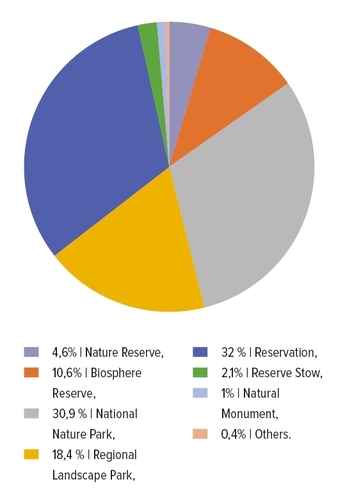
Figure 1 Protected Areas of National and Local Importance in Ukraine
Table 1 Protected areas (Pas) in Ukraine
Table 2 shows classification of national protected areas according to the IUCN categories.
Ukraine is systematically working on the expansion of the protected area network. Even in 2022, during the war, new protected areas were created in various regions (Figure 2).
Figure 2 Dynamics of establishing national and local Protected Areas, million ha
Also, within the framework of integration into the European Union’s nature conservation system and Europe as a whole, Ukraine has been increasing and enlarging the Emerald Network and implementing the EU Habitats and Birds Directives. The Emerald Network in Ukraine is currently sufficient for 40% of flora and fauna species and natural habitats, based on outputs of the biogeographic seminars of the Bern Convention1.
In 2021, Ukraine submitted an updated Emerald Network database, which includes 161 new sites with an area of about 20,000 km2. New sites were proposed by the Ukrainian Nature Conservation Group (UNCG) and the Ukrainian Society for the Protection of Birds with the participation of hundreds of scientists. These are mainly sites in the steppe zone with endemic habitats, in the Crimean Peninsula, seagrass fields, important peat-bogs in the north of Ukraine, and natural forests of the Carpathian Mountains.
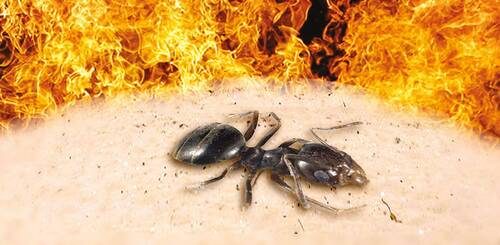
Threatened ant species Tapinoma kinburni. © V. G. Bondarenko, edited by M. Shamin. https://redbook.land.kiev.ua/276.html

Damaged terrain in the Kamianska Sich National Park. © K. Polianska
Losses of protected areas during the war
The full-scale military invasion of the Russian Federation on the territory of Ukraine caused many disasters for the country and its inhabitants. According to the Kyiv School of Economics, as of December 2022, the total amount of documented damage to Ukraine’s infrastructure due to the full-scale invasion launched by Russia on February 24, 2022, is estimated at USD 137.8 billion (at replacement cost)2.
Damages from the destruction of the housing stock are estimated at USD 54 billion. For more than ten months of the war, a total of 149,300 residential buildings were damaged or destroyed.
Russia continues to destroy educational institutions of Ukraine. The amount of damage in this sphere has increased by USD 400 million and estimated at USD 8.6 billion. As a result of hostilities, more than 3,000 educational institutions have already been damaged or destroyed, among them: 1,400 — high schools, 865 — kindergartens, 505 — colleges & universities.
More than a third of the Ukraine’s population became displaced people, of which about 8 million became refugees in other countries. 2.4 million Ukrainians completely lost their homes.
During the 11 months of the war, Russian aggression caused damage to the environment at more than USD 46 billion.
Such figures are calculated according to the methodologies that determine the amount of damage caused to land, water and atmosphere. The total amount of damage caused by soil pollution is more than USD 18.2 billion, while that by air pollution is USD 26.4 billion. For water pollution the damage is estimated at more than USD 1.4 billion3. Some types of damage have still been impossible to assess. For example, half a million hectares of forests are under occupation and in the hostilities zone4.
According to the latest calculations by the Ukraine’s Ministry of Environmental Protection and Natural Resources and international experts, as a result of the war, at least 33 million tons of CO2 equivalent emissions have been recorded. In particular:
• caused by hostilities - about 8.9 million tons of CO2 eq;
• caused by migration of internally displaced persons - about 1 million tons of CO2 eq;
• caused by fires – more than 23.4 million tons of CO2 eq.
Another 48.7 million tons of CO2eq are estimated to become indirect emissions of greenhouse gases due to post-war reconstruction.
From February 24, 2022, to January 11, 2023, Ukraine’s State Emergency Service neutralized 313,564 explosive devices, including 2,157 aircraft bombs, and surveyed an area of 777 km2 for explosives. A total of 174,000 square kilometers in Ukraine (around 30% of country’s territory) has been remaining potentially dangerous5.
At the moment, Ukraine is under a threat of destruction due to the war:
• 16 Ramsar sites covering 6,000 km2 or 81.6 % of all Ramsar sites in Ukraine;
• 160 Emerald Network sites with an area of 29,000 km2 or 35.8 % of all Emerald Network in Ukraine;
• 900 protected areas of national or local importance with an area of 12,400 km2 or 29.7 %.
These areas are destroyed by the destructive actions of explosions, the movement of military equipment, the construction of fortifications, fires as a result of shellings, chemical contamination of the soil by explosive substances, etc. Animals, who have enjoyed safe conditions and the absence of people during the decades of the nature conservation regime within protected areas, die or try to escape from the war zone, are exhausted due to the forced change of migration routes and lack of opportunity to rest.
General information about the damage caused to protected areas can be determined only after the liberation of the territory of Ukraine, cessation of hostilities, and demining, but the scale of the destruction can be projected by analyzing individual examples.
More than 4,780 hectares have been burned on the protected areas of Kinburn Peninsula, Mykolaiv, and Kherson regions (Black Sea Biosphere Reserve, Ivory Coast of Sviatoslav National Nature Park, and the Kinburn Spit Regional Landscape Park) based on deciphering satellite images. In general, the habitats (nesting sites) of approximately 100 bird species, were destroyed in the above areas. Birds were also affected by powerful disturbance from explosions, flashes of light, heavy equipment movements, and military presence6.
Tapinoma kinburni is a unique ant species on the Kinburn Peninsula that is very rare because of steppe plowing. Its habitat became the locations of Ukraine’s most horrific battles. The other localities of this species on the territory of Ukraine are also in the active war zone. There is a threat that this species has become extinct in Ukraine.
According to the Ministry of Environmental Protection and Natural Resources of Ukraine, Russian invaders destroyed 80% of Sviati Hory National Nature Park, Donetsk region. Instead of forests, there is only burnt soil in many places. Up to 60-70% of pine forest (about 50 km2) has been destroyed. The park’s infrastructure suffered significant damage - vehicles, computers, and other equipment have been destroyed or stolen. The damage to the park’s property only is estimated at USD 0.15 million.
The Kamianska Sich National Park in the Kherson region is a steppe area, more than 50 kilometers of the Dnipro River coastline, protecting over 90 rare animal species. Ukraine’s defense forces liberated the park on November 11, 2022 after eight months of occupation. The damage assessment in the park has already begun: in mid-October 2022, thanks to satellite analysis, it was determined that almost 635 hectares of valuable areas, where vulnerable rare plant species were growing, had burned. From February 24 to October 18, 2022 fires damaged rare plant populations within the park, including Genista scythica, Stipa asperella, S. capillata, S. lessingiana and Stipa ucrainica7.
The Chornobyl Radiation and Ecological Biosphere Reserve (Kyiv region) is Ukraine’s youngest and largest reserve. The reserve is an unusual combination of a protected area and the site of the largest radiation accident at a civilian nuclear facility. For 36 years in the Exclusion Zone, nature has been restored itself. Over 300 vertebrate species live freely on 2 269 km2, of which 75 species listed in the Red Book of Ukraine.
However, this balance can change when a forest affected with radiation burns and when the ground cover is disturbed, horizons contaminated by radiation are released from under 30-year vegetation. Russian troops targeted this result, causing powerful forest fires and equipping a camp for several hundreds of tanks and various armored vehicles in the most contaminated part of the Chornobyl zone.
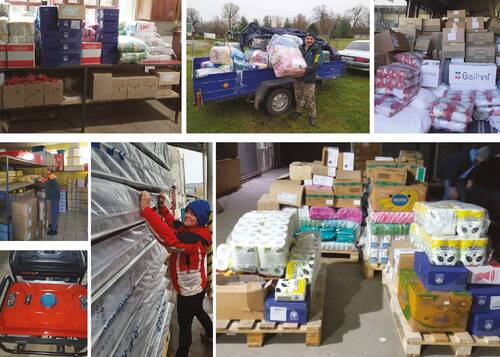
Photos from Ukraine’s protected areas where administration staff helped internally displaced persons. © Authors’ archive
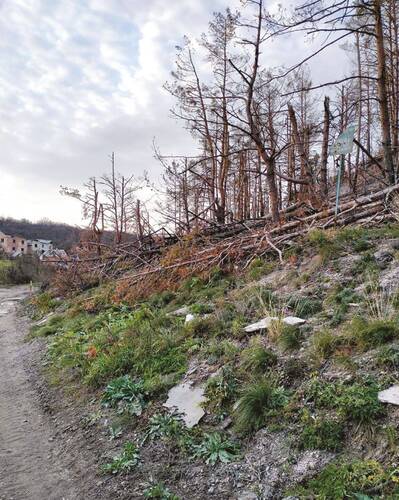
Destroyed nature in the Sviatoslav National Nature Park. © Anastasia Drapaliuk
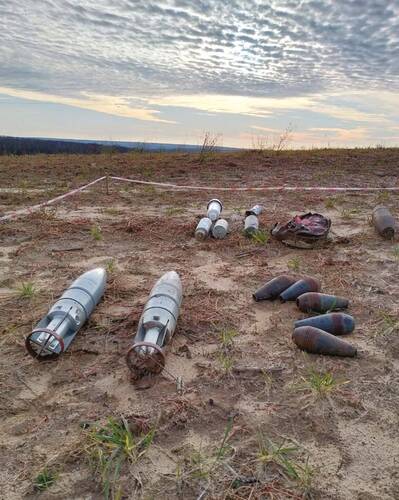
Destroyed nature in the Sviatoslav National Nature Park. © Anastasia Drapaliuk
Conservationists during the war
The Ukraine’s protected areas network staff includes more than 7,000 people, who, from the very first days of the large-scale invasion of Russia, are forced to defend nature under mortal threat. Those in temporarily occupied territories and the area of active operations are under constant pressure from the Russian occupiers. There are cases of abduction of people, murder and torture, and the destruction of houses. There is no electricity and communication, personal hygiene and sanitary products, and food.
And even in such conditions, protected areas continue to work: articles are being prepared, biodiversity databases are being established, eco-educational work is being conducted, if possible, fires are being stopped, and the territory is being protected.
The Askania-Nova Biosphere Reserve in the Kherson region has been under occupation for eight months. Reserve staff continues to protect the territory and take care of its animals and dendrological park. Benefactors help to cover the reserve’s expenses on food and veterinary drugs.
Askania-Nova is a valuable reserve for Ukraine, but its ecosystem is not as natural as in other parks. Approx. 1,500 large ungulates, the zoo, and many birds live in this reserve in semi-wild conditions, and their lives depend entirely on the reserve’s employees. If Askania Nova staff evacuates, the animals will die.
Research in the Kamianska Sich National Park has been continued during the occupation. Until Russians mined the park before retreating, scientists kept records of phenological changes. The park staff also puts out wildfires on their own: they borrowed a tractor with a tank from a local farmer. Even though the park is liberated, the employees do not have access to most of its territory due to shelling and mines.
The northern border of the Dvorichanskyi National Park in the Kharkiv region coincides with the state border with Russia. Due to its location, the national park was occupied in the first days of the full-scale invasion. In September 2022, the Ukrainian military liberated it. Even during the occupation, scientists continued to work: they collected field entomological material and conducted botanical research8.
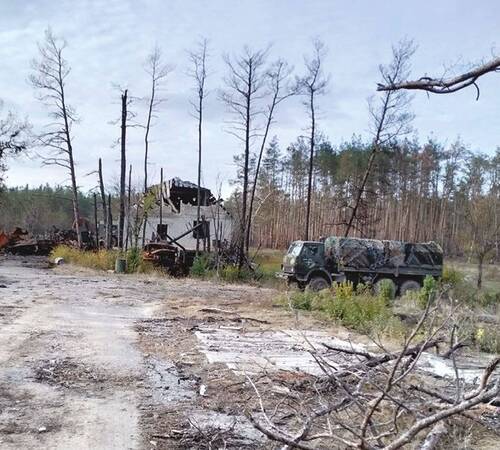
Russian military aggression has not avoided the Sviatoslav National Nature Park: Administration’s Headquarters was also destroyed. © Anastasia Drapaliuk
Another mission of conservationists
With the beginning of the large-scale Russian invasion, protected areas took on another mission - to help internally displaced persons.
Since February 24, 2022 protected area staff has organized a shelter for over 60,000 internally displaced persons (IDP).
Most of the IDPs came from the southeastern regions of Ukraine, particularly from the city of Mariupol. The total number of IDPs was more than 12,000. The Meotyda National Nature Park staff in the Donetsk region gave them shelter in its administration building. And, risking their lives, they evacuated people out of Mariupol under shellings.
The Sviati Hory National Nature Park became a shelter for almost 8,000 people from Izyum, Severodonetsk, Rubizhne, and others. Together with the Sviatohirsk City Council, volunteers, and benefactors, the national park employees provided accommodation and humanitarian aid to all who needed it.
Many IDPs also found a refuge in the Verkhovyna, Vyzhnytsia, and Carpathian National Nature Parks. Almost all of Ukraine’s protected areas generally assisted displaced persons9.
Also, many conservationists went to the army because their skills in nature protection are critically important in defense of the state.
Nature restoration after the war
Biodiversity restoration will be one of the most important challenges after the liberation of the Ukraine’s territory. The process will take decades or perhaps even centuries and will require the assistance of many scientists and conservationists from all over Europe and the world.
Recovery measures should be developed individually for each damaged area and consider global processes. Some areas will need to be conserved so that nature could recover itself, while other areas will need to be actively managed.
It is impossible to restore Ukraine’s nature using only domestic knowledge and to take measures only within the country because natural processes are going beyond the borders.
From the first days of the war, Ukraine, together with international partners, began work on developing a plan for the protected area restoration, as a component of the general plan for the restoration of Ukraine.
The former includes not only the direct restoration of damaged areas, but also the reform of the nature protection system:
• Implement the EU nature conservation legislation (Habitats and Birds Directives);
• Establish a high-quality system of protected area governance and management both at the national and local level in accordance with the best European and world practices; reform the ranger service;
• Launch a permanent biodiversity monitoring scheme;
• Expand the protected area network, taking into account the consequences of military operations;
• Provide high-quality, conservation-oriented, tourist products, etc.
We are grateful for the support of the European nature conservation community - governments, protected areas administrations, NGOs, and individual conservationists.
This help provides an opportunity and inspires us to continue implementing nature conservation measures even under the conditions of threat to physical survival. ■
|
More information about Ukraine’s protected areas during the war: |
- - - -
1 https://www.coe.int/en/web/bern-convention/conclusions-of-the-biogeographical-seminars
3 https://www.dei.gov.ua/post/2499
4 Weekly update on the environmental damage caused by the Russia’s war of aggression against Ukraine (30 January 2023), https://us10.campaign-archive.com/?u=284d761860729672556585dea&id=8763ec4416
5 Weekly update on the environmental damage caused by the Russia’s war of aggression against Ukraine (16 January 2023), https://us10.campaign-archive.com/?u=284d761860729672556585dea&id=b48a4bea89
6 Weekly update on the environmental damage caused by the Russia’s war of aggression against Ukraine (16 January 2023) , https://us10.campaign-archive.com/?u=284d761860729672556585dea&id=b48a4bea89
7 Weekly update on the environmental damage caused by the Russia’s war of aggression against Ukraine (26 December 2022), https://us10.campaign-archive.com/?u=284d761860729672556585dea&id=eea79a8eb2
8 Weekly update on the environmental damage caused by the Russia’s war of aggression against Ukraine (24 October 2022), https://us10.campaign-archive.com/?u=284d761860729672556585dea&id=a94f6f8dce
9 Weekly update on the environmental damage caused by the Russia’s war of aggression against Ukraine (31 October 2022), https://us10.campaign-archive.com/?u=284d761860729672556585dea&id=fd1ac514d0
- - - -
Cover photo:
Ivory Coast of the Sviatoslav National Nature Park. © Victoria Bogovenko
- - - -




